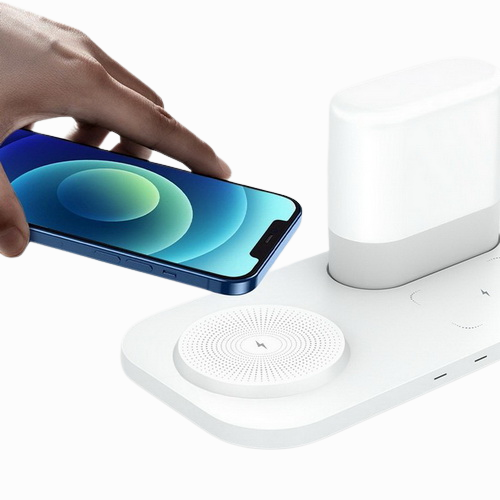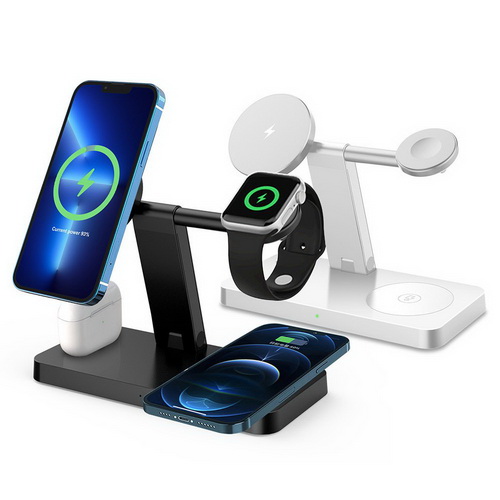The principle of беспроводное зарядное устройство is mainly based on the principle of electromagnetic induction. The following is the detailed working principle of the wireless charger:
Basic principle
Conversion of electrical energy to RF signal: The power supply converts electrical energy into a high-frequency AC electrical signal (usually 100-300 KHZ), which contains energy information.
Signal transmission: The transmission of energy through magnetic fields or electromagnetic waves in space. This magnetic field or electromagnetic wave can be alternating magnetic field, electromagnetic wave or microwave. When the receiver enters the range of a magnetic field or electromagnetic wave, it senses an alternating electromagnetic field, which creates an inverse voltage drop.
Energy harvesting: An induction coil in the receiver captures this inverse voltage drop and converts it to direct current. This process is called “electromagnetic induction” or “magnetic induction”.
Dc is converted into electricity: the collected DC is sent to the charging device, and then through the rectification, filtering and other links, and finally output stable DC for the device to use.
Concrete process
Transmitter: There is a transmitter coil in the wireless charger (usually called the transmitter helix), when the power is turned on, the wireless charger will drive the transmitter coil through the current, generating an alternating electromagnetic field.
Receiving end: There is also a receiving coil (often called a receiving helix) in the device that needs to be charged. When the device is near and aligned with the wireless charger, the receiving helix senses the magnetic field generated by the transmitting helix.
Electromagnetic induction: According to Faraday’s law of electromagnetic induction, when there is a changing magnetic field between two coils, that is, when the magnetic field generated by the transmitting helix intersects with the receiving helix, an induced current will be generated in the receiving helix.
Energy transmission: By induction of current, the receiving coil in the device can convert electrical energy into direct current, and supply the device for charging, filling the battery in the device or for direct power supply.
Type of wireless charger
There are two main types of wireless chargers on the market:
Magnetic induction wireless charger: Uses a magnetic field to transmit energy between the receiver and transmitter. This method is similar to the working principle of transformers and is the most common wireless charging technology at present, mainly used in smartphones and small electronic devices.
Magnetic resonance wireless charger: The magnetic field of two resonant frequencies is used to transmit energy between the transmitter and the receiver. Compared with electromagnetic induction charging, magnetic resonance charging can achieve a larger charging distance, and the alignment requirements of position and direction are relaxed. In addition, it can also achieve efficient (some transmission efficiency of more than 80%) power supply, even one-to-many power supply.
Steps to use wireless charger
Ensure compatibility: First, make sure you have a device that is compatible with wireless charging, such as a smartphone, smart watch, etc. At the same time, prepare a wireless charger that supports the corresponding wireless charging standard.
Place the device: Place the device on the charging area of the wireless charger. Usually, the charging area of the wireless charger will have a clear identification, such as a circle or pattern. Make sure the charging interface of the device is aligned with the charging area of the wireless charger for the best charging results.
Connect to Power: Use the included USB cable to connect the wireless charger to a power outlet. Ensure that the USB cable is securely inserted into the wireless charger and the power socket to avoid loosening during charging and resulting in charging interruption.
Start charging: When the device is placed on the wireless charger and the charger is connected to the power supply, the device will start charging automatically. You can determine the charging status by observing the charging icon or charging indicator on the device screen.
Monitor charging progress: During charging, the charging progress can be monitored through the device’s screen or charging indicator. Most devices will display a charging percentage or charging icon in order to understand the real-time status of charging.
End charging: When the device is fully charged or needs to use the device, gently pick up the device. Please note that before picking up the device, make sure that the charging has been completed or the device has been disconnected from the wireless charger, so as not to accidentally disconnect the charge and cause damage to the device.
In general, the wireless charger realizes the wireless transmission of electric energy through the principle of electromagnetic induction or magnetic resonance, providing users with a more convenient and efficient way to charge.



